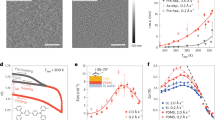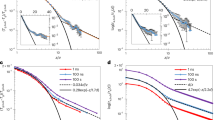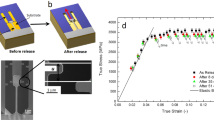Abstract
Many emerging materials, such as ultrastable glasses1,2 of interest for phone displays and OLED television screens, owe their properties to a gradient of enhanced mobility at the surface of glass-forming liquids. The discovery of this surface mobility enhancement3,4,5 has reshaped our understanding of the behaviour of glass formers and of how to fashion them into improved materials. In polymeric glasses, these interfacial modifications are complicated by the existence of a second length scale—the size of the polymer chain—as well as the length scale of the interfacial mobility gradient6,7,8,9. Here we present simulations, theory and time-resolved surface nano-creep experiments to reveal that this two-scale nature of glassy polymer surfaces drives the emergence of a transient rubbery, entangled-like surface behaviour even in polymers comprised of short, subentangled chains. We find that this effect emerges from superposed gradients in segmental dynamics and chain conformational statistics. The lifetime of this rubbery behaviour, which will have broad implications in constraining surface relaxations central to applications including tribology, adhesion, and surface healing of polymeric glasses, extends as the material is cooled. The surface layers suffer a general breakdown in time−temperature superposition (TTS), a fundamental tenet of polymer physics and rheology. This finding may require a reevaluation of strategies for the prediction of long-time properties in polymeric glasses with high interfacial areas. We expect that this interfacial transient elastomer effect and TTS breakdown should normally occur in macromolecular systems ranging from nanocomposites to thin films, where interfaces dominate material properties5,10.
This is a preview of subscription content, access via your institution
Access options
Access Nature and 54 other Nature Portfolio journals
Get Nature+, our best-value online-access subscription
$29.99 / 30 days
cancel any time
Subscribe to this journal
Receive 51 print issues and online access
$199.00 per year
only $3.90 per issue
Buy this article
- Purchase on Springer Link
- Instant access to full article PDF
Prices may be subject to local taxes which are calculated during checkout




Similar content being viewed by others
Data availability
The data that support the findings of this study are available within the article and its Supplementary Information. Raw simulation trajectories are available upon request from D.S.S.
Code availability
Simulations employ standard codes (LAMMPS) and methods that are freely available or documented in the literature.
References
Swallen, S. F. et al. Organic glasses with exceptional thermodynamic and kinetic stability. Science 315, 353–356 (2007).
Ediger, M. D. Perspective: highly stable vapor-deposited glasses. J. Chem. Phys. 147, 210901 (2017).
Dutcher, J. R. & Ediger, M. D. Glass surfaces not so glassy. Science 319, 577−578 (2008).
Jones, R. A. L. Glasses with liquid-like surfaces. Nat. Mater. 2, 645–646 (2003).
Napolitano, S., Glynos, E. & Tito, N. B. Glass transition of polymers in bulk, confined geometries, and near interfaces. Rep. Prog. Phys. 80, 036602 (2017).
Schweizer, K. S. & Simmons, D. S. Progress towards a phenomenological picture and theoretical understanding of glassy dynamics and vitrification near interfaces and under nanoconfinement. J. Chem. Phys. 151, 240901 (2019).
Ellison, C. J. & Torkelson, J. M. The distribution of glass-transition temperatures in nanoscopically confined glass formers. Nat. Mater. 2, 695–700 (2003).
Priestley, R. D., Ellison, C. J., Broadbelt, L. J. & Torkelson, J. M. Structural relaxation of polymer glasses at surfaces, interfaces, and in between. Science 309, 456–459 (2005).
Pye, J. E., Rohald, K. A., Baker, E. A. & Roth, C. B. Physical aging in ultrathin polystyrene films: evidence of a gradient in dynamics at the free surface and its connection to the glass transition temperature reductions. Macromolecules 43, 8296–8303 (2010).
Yu, L. Surface mobility of molecular glasses and its importance in physical stability. Adv. Drug Deliv. Rev. 100, 3–9 (2016).
Jackson, C. L. & McKenna, G. B. The glass transition of organic liquids confined to small pores. J. Non-Cryst. Solids 131–133, 221–224 (1991).
Keddie, J. L., Jones, R. A. L. & Cory, R. A. Size-dependent depression of the glass transition temperature in polymer films. Europhys. Lett. 27, 59–64 (1994).
Fakhraai, Z. & Forrest, J. A. Measuring the surface dynamics of glassy polymers. Science 319, 600–604 (2008).
Paeng, K., Swallen, S. F. & Ediger, M. D. Direct measurement of molecular motion in freestanding polystyrene thin films. J. Am. Chem. Soc. 133, 8444–8447 (2011).
Ediger, M. D. & Forrest, J. A. Dynamics near free surfaces and the glass transition in thin polymer films: a view to the future. Macromolecules 47, 471–478 (2014).
Yang, Z., Fujii, Y., Lee, F. K., Lam, C-H. & Tsui, O. K. C. Glass transition dynamics and surface layer mobility in unentangled polystyrene films. Science 328, 1676–1679 (2010).
Chai, Y. et al. A direct quantitative measure of surface mobility in a glassy polymer. Science 343, 994–999 (2014).
Li, Y. et al. Surface diffusion in glasses of rod-like molecules posaconazole and itraconazole: effect of interfacial molecular alignment and bulk penetration. Soft Matter 16, 5062–5070 (2020).
Flier, B. M. I. et al. Heterogeneous diffusion in thin polymer films as observed by high-temperature single-molecule fluorescence microscopy. J. Am. Chem. Soc. 134, 480–488 (2012).
Xu, Q. et al. Decoupling role of film thickness and interfacial effect on polymer thin film dynamics. ACS Macro Lett. 10, 1–8 (2021).
Toney, M. F. et al. Near-surface alignment of polymers in rubbed films. Nature 374, 709–711 (1995).
Maeda, N., Chen, N., Tirrell, M. & Israelachvili, J. N. Adhesion and friction mechanisms of polymer-on-polymer surfaces. Science 297, 379–382 (2002).
Tanaka, K., Takahara, A. & Kajiyama, T. Rheological analysis of surface relaxation process of monodisperse polystyrene films. Macromolecules 33, 7588–7593 (2000).
Ma, J. et al. Fast surface dynamics enabled cold joining of metallic glasses. Sci. Adv. 5, eaax7256 (2019).
Li, X. et al. Low‐temperature processing of polymer nanoparticles for bioactive composites. J. Polym. Sci. B 54, 2514–2520 (2016).
Chen, F., Lam, C.-H. & Tsui, O. K. C. The surface mobility of glasses. Science 343, 975–976 (2014).
Sokolov, A. P. & Schweizer, K. S. Resolving the mystery of the chain friction mechanism in polymer liquids. Phys. Rev. Lett. 102, 248301 (2009).
Hung, J.-H., Mangalara, J. H. & Simmons, D. S. Heterogeneous rouse model predicts polymer chain translational normal mode decoupling. Macromolecules 51, 2887–2898 (2018).
Rubinstein, M. & Colby, R. H. Polymer Physics (Oxford Univ. Press, 2003).
Carré, A., Gastel, J.-C. & Shanahan, M. E. R. Viscoelastic effects in the spreading of liquids. Nature 379, 432–434 (1996).
Shanahan, M. E. R. & Carré, A. Spreading and dynamics of liquid drops involving nanometric deformations on soft substrates. Colloids Surf. A 206, 115–123 (2002).
Jerison, E. R., Xu, Y., Wilen, L. A. & Dufresne, E. R. Deformation of an elastic substrate by a three-phase contact line. Phys. Rev. Lett. 106, 186103 (2011).
Lu, H., Chen, W. & Russell, T. P. Relaxation of thin films of polystyrene floating on ionic liquid surface. Macromolecules 42, 9111–9117 (2009).
Fetters, L. J., Lohse, D. J., Richter, D., Witten, T. A. & Zirkel, A. Connection between polymer molecular weight, density, chain dimensions, and melt viscoelastic properties. Macromolecules 27, 4639–4647 (1994).
Plazek, D. J. & O’Rourke, V. M. Viscoelastic behavior of low molecular weight polystyrene. J. Polym. Sci. A-2 9, 209–243 (1971).
Yang, J. & Schweizer, K. S. Glassy dynamics and mechanical response in dense fluids of soft repulsive spheres. II. Shear modulus, relaxation-elasticity connections, and rheology. J. Chem. Phys. 134, 204909 (2011).
Humphrey, W., Dalke, A. & Schulten, K. VMD — visual molecular dynamics. J. Mol. Graph. 14, 33–38 (1996).
Lang, R. J. & Simmons, D. S. Interfacial dynamic length scales in the glass transition of a model freestanding polymer film and their connection to cooperative motion. Macromolecules 46, 9818–9825 (2013).
Khantha, M. & Balakrishnan, V. First passage time distributions for finite one-dimensional random walks. Pramana 21, 111–122 (1983).
Kröger, M. Shortest multiple disconnected path for the analysis of entanglements in two- and three-dimensional polymeric systems. Comput. Phys. Commun. 168, 209–232 (2005).
Si, L., Massa, M. V., Dalnoki-Veress, K., Brown, H. R. & Jones, R. A. L. Chain entanglement in thin freestanding polymer films. Phys. Rev. Lett. 94, 127801 (2005).
Brown, H. R. & Russell, T. P. Entanglements at polymer surfaces and interfaces. Macromolecules 29, 798–800 (1996).
Acknowledgements
We thank N. L. Yamada for assisting with the neutron reflectivity measurements and O. K. C. Tsui and J. J. Zhou for discussions. B.Z. acknowledges financial support from the Natural Science Foundation of China (grant numbers 21973083 and 21504081), and R.D.P. and K.R. acknowledge support from the National Science Foundation (NSF) Materials Research Science and Engineering Center Program through the Princeton Center for Complex Materials (grant numbers DMR-1420541 and DMR-2011750) and the NSF through grant number CBET-1706012. D.S.S. and A.G. acknowledge support from the National Science Foundation through grant number CBET-1854308. X.W. thanks the Natural Science Foundation of China (grant numbers 21674100 and 21873085), and K.T. acknowledges the JST-Mirai Program (JPMJMI18A2). We also acknowledge the BL-16 line at J-PARC (programme no.2017L2501) for providing beam time.
Author information
Authors and Affiliations
Contributions
B.Z. and R.D.P. conceived and supervised the experiments. Z.H., N.Z. and K.R. performed experiments. D.S.S. and A.G. conceived and analysed all simulations and theories. A.G. performed all simulations under the supervision of D.S.S. D.K. and K.T. provided neutron reflectivity data. All authors discussed the results and wrote the manuscript.
Corresponding authors
Ethics declarations
Competing interests
The authors declare no competing interests.
Additional information
Peer review information Nature thanks the anonymous reviewer(s) for their contribution to the peer review of this work.
Publisher’s note Springer Nature remains neutral with regard to jurisdictional claims in published maps and institutional affiliations.
Supplementary information
Supplementary Information
This file contains notes on the theoretical development, Supplementary Simulation Methods, Supplementary Data, Supplementary Table 1, Supplementary Figs 1-16 and Supplementary References.
Rights and permissions
About this article
Cite this article
Hao, Z., Ghanekarade, A., Zhu, N. et al. Mobility gradients yield rubbery surfaces on top of polymer glasses. Nature 596, 372–376 (2021). https://doi.org/10.1038/s41586-021-03733-7
Received:
Accepted:
Published:
Issue Date:
DOI: https://doi.org/10.1038/s41586-021-03733-7
Comments
By submitting a comment you agree to abide by our Terms and Community Guidelines. If you find something abusive or that does not comply with our terms or guidelines please flag it as inappropriate.



